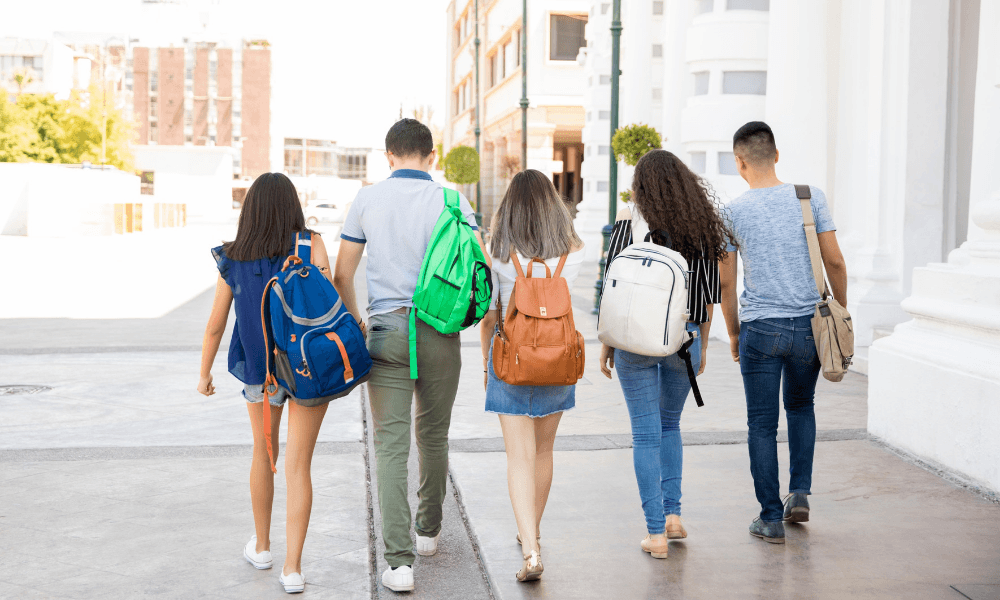According to the World Health Organization, one school backpack should not weigh more than 10% of a child's weight.
In February 2017, 48,000 Portuguese signed a public petition "against the excessive weight of school backpacks in Portugal". In accordance with the Deco, who did a study at that time weighing 174 children and their respective backpacks came to the conclusion that66% of the kids in the sample were carrying more weight on their backs than recommended!”.
"You countries must have a proactive and unequivocal role in monitoring this situation, weighing the children's backpack and alerting the teachers or the school” explained the campaign coordinator "Watch your back” in a interview to the Life notebook of DN. "Excessive weight in backpacks is linked to muscle contractures, poor posture, and overload of the spinal discs", comments the same article from DN.
"THE repeated transport of a heavy backpack may condition, in the future, serious problems for children's backs. In addition to the back pain that children probably complain about on a daily basis, this habit can cause increased wear of the child's spine over time, seriously harming your long-term health" clarified the neurosurgeon Paulo Pereira to Sapo Lifestyle.
Many times these back problems are staying camouflaged since children and adolescents often are not clear about the pains and problems they feel in their backs. But we must be attentive to the signs: if the children they complain when they put on or take off the backpack from their backs, he has marks on the shoulders or complain that their shoulders, arms, or hands become numb, there is to take immediate action.
The illustration of the HuffPost, quite well depicts these problems:
Who first has to monitor and manage the type of backpacks and the weight that children carry inside are the parents themselves.
The campaign Light Backpack, from the Directorate-General for Education, recommends that the countries follow the following recommendations:
-
Acquire ergonomically suitable backpacks.
-
Acquire lightweight materials (cases, notebooks, and other auxiliary materials).
-
Opt for notebooks or dossiers that allow the use of a single notebook or dividers.
-
Opt for backpacks with wheels (trolley type).
- If the option is strap backpack:
- Use the backpack on your back for the minimum possible time;
- Properly distribute the school supplies inside the backpack, placing the heaviest items closest to the back.
- Check if only school supplies and equipment (electronic, computer, toys, etc.) that are useful and strictly necessary are transported.
-
Check if the material that is no longer usable is removed from the backpack.
-
Use lightweight and sustainable materials, whenever students bring snacks to school.
- Promote awareness actions in Parents' Associations.
In short, first of all, parents have to ensure that the backpack that the children use is placed correctly, which carry strictly necessary and that the posture of your children is appropriate.
But some care will compete also to the school and the teachers, like the campaign Light Backpack recommends to them:
-
Encourage the use of lockers, either shared or individual, depending on capacity, allowing heavier materials to remain at school.
-
Preferably distribute the same room for each class, so that the materials can be left in the room during breaks.
-
Ensure, whenever possible, that the manuals stay at school.
-
Plan the lessons predicting whether the manuals will be used, to prevent students from bringing them to school when they are not needed.
-
Notify students about which volumes and manuals are necessary for the next class, allowing them to bring only the necessary material.
-
Select activities to be done at home, when necessary, considering the material that needs to be transported.
-
Plan ways to use notebooks or folders that allow the use of a single notebook or dividers.
-
Promote the shared use of manuals, on a rotating basis, alternating the day on which different students bring the books to class.
- Promote awareness actions in each school, involving all the school community.
In addition to these solutions, it also contributes to the digital transformation of school textbooks and the teaching process in general. The existence of digital school manuals, the use of Internet, for study and research, and to word processors and spreadsheets for the preparation of papers and presentations, comes to allow new features to students whenever used in a balanced way.
But this digital transformation also comes to require new care: students often need take the computers with you to school or university, carrying even more weight in the backpack.
The purchase of a computer light but sufficiently resistant to be carried around daily and with the necessary performance to the student's tasks clearly puts a challenge to parents.
The solution of the refurbished computers for students (link to article: why a Refurbished computer is ideal for students) comes to allow, the low cost, one professional quality and robustness, which would only be available at exorbitant prices, incompatible with the family budgets of most students and above all constituting a great risk since the loss or theft of this equipment remains a constant concern for parents.
Buy one refurbished computer, besides having a huge impact on the environment, means for the student to have access to a lightweight machine, much more powerful and robust that the non-professional machine, in condition practically new, but to a much lower price.
After all, the students are or are not also professionals?





Share this article:
Do you want a world without plastic? See where to start!
Tools for working from home